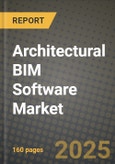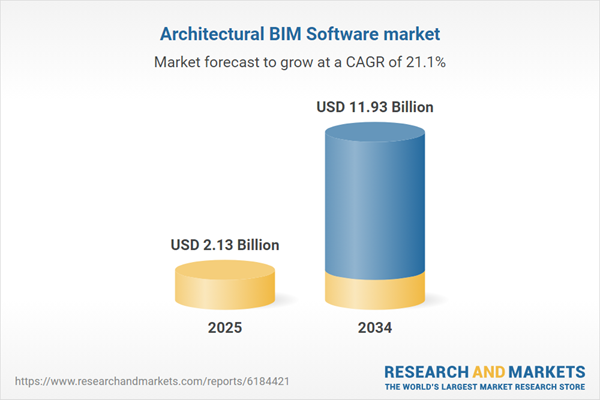Architectural BIM Software market
The Architectural BIM Software Market is transforming the global building design and construction ecosystem through data-driven, model-centric workflows. It integrates architectural modeling, visualization, coordination, and documentation within a unified digital environment, enabling seamless collaboration across stakeholders. Major applications include schematic design, parametric modeling, energy and daylight analysis, design coordination, and digital handover for facility management. The market is shaped by the increasing adoption of openBIM standards (IFC, BCF), cloud-based collaboration platforms, and the integration of AI-driven generative design tools. Key drivers include regulatory BIM mandates, sustainability certifications, digital permitting initiatives, and the growing emphasis on cost and time optimization across complex projects. Vendors compete on interoperability, scalability, and ecosystem integration, with solutions ranging from enterprise-grade suites to lightweight cloud authoring tools tailored for small and mid-sized firms. Subscription-based pricing models dominate, supported by modular cloud extensions for collaboration, analytics, and automation. Leading providers focus on enhancing usability, automating code checks, and linking BIM data with construction and asset management platforms to create end-to-end digital twins. Challenges persist around high implementation costs, workforce upskilling, and integration with legacy CAD or ERP systems. Emerging trends include AI-assisted detailing, generative massing, reality capture integration, and automated quality audits. The Architectural BIM Software Market continues to evolve from design documentation toward lifecycle intelligence, positioning itself as the digital foundation for sustainability, performance analytics, and resilient urban development.Architectural BIM Software market Key Insights
- Regulatory pull & owner mandates: Government BIM requirements and model-based submittals accelerate adoption, especially on public and large institutional projects. Owners seek standardized deliverables, data handover, and traceability aligned to ISO 19650.
- Cloud collaboration becomes default: CDEs, model federation, and issue tracking move to the cloud for distributed teams. Real-time co-authoring, permissions, and audit trails compress design cycles and reduce coordination risk.
- Interoperability is a buying criterion: Robust IFC/BCF, gbXML, and API openness drive vendor selection. Firms prioritize smooth handoffs to structural/MEP tools, coordination/checking software, and construction management platforms.
- AI and generative workflows emerge: Layout suggestions, auto-tagging, code rule checks, and assisted detailing improve productivity. Early-stage generative massing and daylight/energy feedback inform design decisions faster.
- Sustainability & LCA integration: Embedded energy modeling, embodied-carbon calculators, and material databases support certifications and ESG reporting. Model granularity and product libraries enable credible, repeatable analyses.
- Reality capture to BIM: Laser scanning and photogrammetry feed rapid as-built modeling, retrofit feasibility, and heritage projects. Automated feature extraction and template-based modeling reduce manual rework.
- Content governance & standards: Centralized families/objects, naming conventions, and QA scripts improve consistency across offices. Template libraries shorten onboarding and ensure brand/document quality.
- Practice size segmentation: Enterprise studios value portfolio governance, SSO, analytics, and global templates; SMBs seek affordability, ease of use, and curated onboarding. Vendors tailor bundles and training paths accordingly.
- Performance & scalability matter: Large mixed-discipline models require efficient geometry kernels, view generation, and caching. Hardware guidance and cloud compute offload are differentiators on complex projects.
- From design to delivery: Tighter links to quantity take-off, 4D/5D planning, and field capture close the loop. Structured model data supports procurement, pre-fab, and lifecycle FM/digital twin transitions.
Architectural BIM Software market Reginal Analysis
North America
Market adoption is led by federal and state BIM mandates, integrated project delivery, and cloud-based collaboration for distributed design teams. Energy codes and sustainability goals drive the use of BIM-integrated simulations, while universities and professional bodies promote standardized execution plans. Software providers prioritize interoperability with coordination, estimating, and field tools to enhance connected workflows.Europe
Europe demonstrates high BIM maturity, underpinned by public procurement mandates and strong openBIM adoption. Practices emphasize ISO 19650 compliance, lifecycle data integration, and multilingual content libraries. Northern and Western Europe pioneer automated code checking and digital permitting, while Central and Eastern regions expand through EU-funded infrastructure programs and public housing modernization.Asia-Pacific
Rapid urbanization and government mandates in countries like China, Japan, South Korea, and Australia are accelerating BIM implementation. Large-scale urban redevelopment, prefabrication, and smart infrastructure projects drive adoption. Vendors localize content libraries and training modules, while cloud collaboration enables cross-border coordination and contractor integration for megaprojects.Middle East & Africa
The region’s adoption centers around high-value projects in hospitality, healthcare, and smart cities. Developers enforce BIM requirements to improve design coordination and construction speed. Cloud collaboration, sustainability analysis, and digital twin integration are emerging priorities, supported by partnerships between global technology vendors and local implementation consultants.South & Central America
Market growth is driven by urban infrastructure development and government-backed digital construction programs. Architects and contractors adopt BIM to enhance cost control and design coordination. Training initiatives and localized content standards support adoption, while cloud-based licensing models make BIM accessible to mid-tier firms and regional design practices.Architectural BIM Software market Segmentation
By Type
- 3D BIM
- 4D BIM
- 5D BIM
- 6D BIM
By Application
- Commercial
- Residential
- Industrial
- Public Infrastructure
By Deployment
- Cloud-Based
- On-Premises
By End-User
- Architects
- Engineers
- Construction Managers
- Others
By Project Lifecycle
- Preconstruction
- Construction
- Post-Construction
Key Market players
Autodesk, Graphisoft, Bentley Systems, Trimble, Vectorworks, Allplan, Bricsys, ACCA software, CYPE Ingenieros, CadLine (ARCHLine.XP), Chief Architect, SoftPlan Systems, Dassault Systèmes, RIB Software, AVEVAArchitectural BIM Software Market Analytics
The report employs rigorous tools, including Porter’s Five Forces, value chain mapping, and scenario-based modelling, to assess supply-demand dynamics. Cross-sector influences from parent, derived, and substitute markets are evaluated to identify risks and opportunities. Trade and pricing analytics provide an up-to-date view of international flows, including leading exporters, importers, and regional price trends.Macroeconomic indicators, policy frameworks such as carbon pricing and energy security strategies, and evolving consumer behaviour are considered in forecasting scenarios. Recent deal flows, partnerships, and technology innovations are incorporated to assess their impact on future market performance.
Architectural BIM Software Market Competitive Intelligence
The competitive landscape is mapped through proprietary frameworks, profiling leading companies with details on business models, product portfolios, financial performance, and strategic initiatives. Key developments such as mergers & acquisitions, technology collaborations, investment inflows, and regional expansions are analyzed for their competitive impact. The report also identifies emerging players and innovative startups contributing to market disruption.Regional insights highlight the most promising investment destinations, regulatory landscapes, and evolving partnerships across energy and industrial corridors.
Countries Covered
- North America - Architectural BIM Software market data and outlook to 2034
- United States
- Canada
- Mexico
- Europe - Architectural BIM Software market data and outlook to 2034
- Germany
- United Kingdom
- France
- Italy
- Spain
- BeNeLux
- Russia
- Sweden
- Asia-Pacific - Architectural BIM Software market data and outlook to 2034
- China
- Japan
- India
- South Korea
- Australia
- Indonesia
- Malaysia
- Vietnam
- Middle East and Africa - Architectural BIM Software market data and outlook to 2034
- Saudi Arabia
- South Africa
- Iran
- UAE
- Egypt
- South and Central America - Architectural BIM Software market data and outlook to 2034
- Brazil
- Argentina
- Chile
- Peru
Research Methodology
This study combines primary inputs from industry experts across the Architectural BIM Software value chain with secondary data from associations, government publications, trade databases, and company disclosures. Proprietary modeling techniques, including data triangulation, statistical correlation, and scenario planning, are applied to deliver reliable market sizing and forecasting.Key Questions Addressed
- What is the current and forecast market size of the Architectural BIM Software industry at global, regional, and country levels?
- Which types, applications, and technologies present the highest growth potential?
- How are supply chains adapting to geopolitical and economic shocks?
- What role do policy frameworks, trade flows, and sustainability targets play in shaping demand?
- Who are the leading players, and how are their strategies evolving in the face of global uncertainty?
- Which regional “hotspots” and customer segments will outpace the market, and what go-to-market and partnership models best support entry and expansion?
- Where are the most investable opportunities - across technology roadmaps, sustainability-linked innovation, and M&A - and what is the best segment to invest over the next 3-5 years?
Your Key Takeaways from the Architectural BIM Software Market Report
- Global Architectural BIM Software market size and growth projections (CAGR), 2024-2034
- Impact of Russia-Ukraine, Israel-Palestine, and Hamas conflicts on Architectural BIM Software trade, costs, and supply chains
- Architectural BIM Software market size, share, and outlook across 5 regions and 27 countries, 2023-2034
- Architectural BIM Software market size, CAGR, and market share of key products, applications, and end-user verticals, 2023-2034
- Short- and long-term Architectural BIM Software market trends, drivers, restraints, and opportunities
- Porter’s Five Forces analysis, technological developments, and Architectural BIM Software supply chain analysis
- Architectural BIM Software trade analysis, Architectural BIM Software market price analysis, and Architectural BIM Software supply/demand dynamics
- Profiles of 5 leading companies - overview, key strategies, financials, and products
- Latest Architectural BIM Software market news and developments
Additional Support
With the purchase of this report, you will receive:- An updated PDF report and an MS Excel data workbook containing all market tables and figures for easy analysis.
- 7-day post-sale analyst support for clarifications and in-scope supplementary data, ensuring the deliverable aligns precisely with your requirements.
- Complimentary report update to incorporate the latest available data and the impact of recent market developments.
This product will be delivered within 1-3 business days.
Table of Contents
Companies Mentioned
- Autodesk
- Graphisoft
- Bentley Systems
- Trimble
- Vectorworks
- Allplan
- Bricsys
- ACCA software
- CYPE Ingenieros
- CadLine (ARCHLine.XP)
- Chief Architect
- SoftPlan Systems
- Dassault Systèmes
- RIB Software
- AVEVA
Table Information
| Report Attribute | Details |
|---|---|
| No. of Pages | 160 |
| Published | November 2025 |
| Forecast Period | 2025 - 2034 |
| Estimated Market Value ( USD | $ 2.13 Billion |
| Forecasted Market Value ( USD | $ 11.93 Billion |
| Compound Annual Growth Rate | 21.1% |
| Regions Covered | Global |
| No. of Companies Mentioned | 15 |









